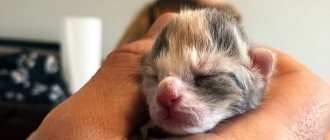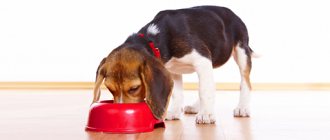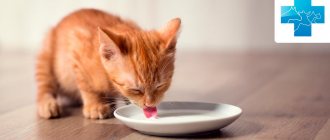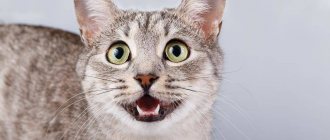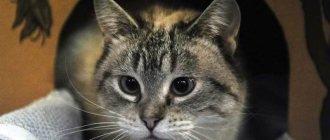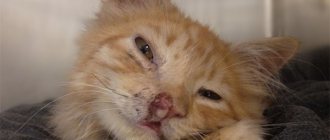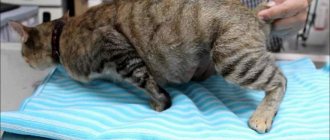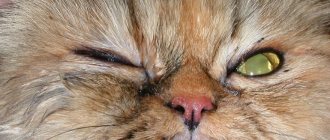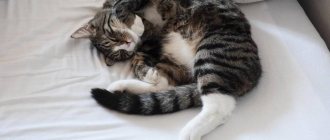Your cat survived the pregnancy and gave birth to kittens. Now it's time for her to take care of her kittens, but for some reason she doesn't want to feed them. She may have completely rejected one or more of her kittens, or you just aren't sure she's feeding the kitten adequately. What should a worried cat owner do?
In most cases, cats give birth to kittens and care for them with little or no human intervention. However, there are times when nature does not take over. That's when people need to step in and offer help.
What you need for feeding
To feed your pets you need to purchase everything you need.
What you need to feed a kitten:
- Special mixtures, nutrition.
- Cat milk substitutes.
- Pipette, disposable syringes without a needle or with a rubber nozzle;
- Bottles with nipple. Use the Catac kitten feeding bottle.
- Disposable moisture-absorbing diapers, cotton pads.
- Medicines for intestinal colic for infants.
Important! There are ready-made kits on sale for feeding small kittens, which contain all the necessary tools and utensils.
Feeding methods
There are several ways to feed a newborn baby with formula or milk substitutes:
- From a spoon , however, this method is used extremely rarely in practice, since it is very inconvenient and is suitable for slightly older animals.
- From a pipette - convenient to use for feeding, as it imitates a cat's nipple, allowing the kitten to develop a sucking reflex.
- From a syringe – this method of serving food to the kitten is given the greatest preference. Using a syringe, it is easy to dose the volume of food, and the kitten is comfortable, since the nose of the syringe is similar to a nipple. The needle is not put on the syringe when feeding.
For feeding, there are special tubes inserted directly into the animal’s stomach. But using such a device without certain skills and abilities is strictly prohibited.
What to feed kittens
Cow's milk is not suitable for this purpose. It has high fat content, which leads to diarrhea. Today, in veterinary pharmacies you can purchase dry formulas that can replace breast milk. In the first days (up to 3 weeks), it is allowed to use dry infant formula Malyutka, Nestozhen, but only with zero sugar content. When the kittens are in a stable condition, vitamins and minerals are gradually added to the mixture, which it is recommended to ask your veterinarian about. You can feed the kitten other foods after its eyes open.
What to do in this situation
If your pet is healthy but ignores newborns, you should try to “persuad” her. You should build a nest in a quiet, warm corner and place the mother and her offspring there. There should be a tray, a cup of food and clean water nearby so that the animal does not go far from the house. It is necessary to take an active part in the pet’s life: monitor the animal’s condition, body temperature, check for the presence of milk, lumps, and discharge from the genitals. Often, an infection in the uterine cavity becomes the reason why a cat does not feed kittens. It is advisable to invite a veterinarian home so that he can examine the mother and newborn kittens for diseases and congenital pathologies. You can find a wet nurse for the babies or take the responsibility of feeding into your own hands.
Attention! You cannot touch kittens without gloves. Human intervention can cause a cat to abandon its babies.
How to reduce the risk of abandonment of offspring
Try to follow the basic rules:
- the cat should have a warm and quiet place for giving birth and subsequent feeding of kittens;
- the cat should eat food high in nutrients;
- there is no need to touch kittens in the first two weeks of their life unless necessary;
- other pets should not have access to the cat with kittens, including the cat.
If the cat does abandon the little kittens, there are other possible reasons:
- the cat is too young and this is her first birth;
- too many kittens;
- after giving birth, the cat developed complications, for example, mastitis;
- the cat has no milk;
Contact your veterinarian for advice. Try to feed the cat food with a high content of nutrients, move her house to a quiet and peaceful place - perhaps after a short time the maternal instinct will kick in and she will return to her cubs.
How to care for kittens
Babies left without parental care need not only proper feeding, but also full care. A person must do everything so that the newborn pet does not feel inferior and receives the proper warmth, attention and affection. Functions of a cat that a person should take on:
- Heating . Kittens lack thermoregulation function. It is important for the baby to equip a “prototype nest”. A box is suitable for this, the bottom of which will need to be covered with a warm cloth. It is better to choose woolen materials that will remind your baby of touching his mother’s wool. Place heating pads with hot water on each side of the box.
- Hygiene . The cat carefully monitors the cleanliness of her cubs, constantly licking them. Therefore, a person should do the same - before each feeding, the kitten should be examined so that there are no inflammations or abscesses on its fur and skin. After feeding, wipe the fur with a damp, sterile cloth. Inspect the tray regularly and clean it as necessary.
- Massage . After feeding, you need to gently massage your tummy with a cotton swab. This will help improve digestion and stimulate the urination process.
The biggest challenge that a person caring for a newborn kitten faces is feeding. To feed kittens, you can use specialized formulas sold in pet stores, or prepare them yourself.
Mastitis
Mastitis is inflammation of the breast tissue. There are many possible causes for the disease, but the result is always the same - severe pain, increased general and local body temperature, as well as refusal to feed the kittens. You can guess the presence of mastitis by the following signs:
- The mammary glands are hot and swollen.
- The cat does not refuse the kittens, but when the babies try to latch on, she begins to meow loudly, snorts, growls, and leaves the box.
- In severe cases, you can see exudate being released from the nipples instead of milk.
If there is any suspicion of mastitis, the kittens are immediately removed from the cat and fed artificially! Even if the cat does not refuse to feed her offspring, the consumption of mastitis milk by kittens will not end well! If the babies have already managed to nurse, then they themselves will probably have to be treated (diarrhea and dehydration are possible).
Reasons for this cat behavior
There are quite a few options for why a cat does this, and they differ from each other. Starting from problems with hormonal levels, ending with ordinary laziness. Let's look at them below and try to understand them in more detail.
- Stress. Stress may be one of the common causes. For example, when a person, after your pet has given birth, intervenes and takes her newborn babies in his hands.
- A change of scenery. It's also not a rare occurrence. When an animal is picked up and moved somewhere, the cat may also become afraid of too bright light. Then the animal can take back its children, but in this case you must be extremely caring and attentive. Whereas the mother herself will find a place for herself and her children.
- Difficult birth. Unfortunately, not only women have complications with childbirth, but cats too. Perhaps the animal is in severe pain and has no time for kittens right now; it is necessary to carefully study the animal’s behavior and perhaps show it to a specialist.
- Laziness. For this reason, the cat owners themselves are often to blame. Throughout your life, you have spoiled your animal and now, when the time has come to take on responsibility, it simply turns out that it is not ready for it.
- The offspring are not viable. Unfortunately, this also happens. But usually, this happens when a sick or old cat gave birth. Animals feel their babies, because they are much closer to nature than people.
- Childbirth for the first time. Another reason why an animal may behave this way. Due to inexperience, she may abandon her children, because she simply does not know what to do with them.
Any of these reasons can happen to a cat, here, as you understand, the owners also have a lot to do with you, try not to pamper your cat so much that after giving birth she will not be able to take care of her children.
What will it take to raise kittens without a cat?
If your cat is preparing to give birth, a list of what will be needed to feed the kittens should be prepared in advance. In the first few hours, you can cuddle the kitten against your own body to warm it up. It wouldn’t hurt to stock up on plenty of natural cotton and terry cloth, cotton pads, gauze, and absorbent bedding.
Medical gloves and scales for regular weighing (the only way to determine the development of kittens) will come in handy. You can buy a bottle with a nipple; at first, pipettes or syringes without a needle will do. Anti-colic medications (such as Espumisan) will come in handy in reserve. A cardboard box can be used as a birthing place; you also need to prepare air-permeable fabric, which will be useful for covering the nest from light. Some people place a mother substitute - a soft toy - next to newborn kittens.
Creating conditions for kittens
To raise a kitten without a cat, you will have to replace the mother not only in the feeding process. You need to provide the kittens with a place to sleep and play, learn how to wash the kitten, and give it a massage.
- A place to sleep. You can use a small box as a sleeping place. Place soft cloths, baby diapers or towels there. During the first weeks of life, the temperature of the kittens' bed should be similar to the mother cat's body temperature. The room temperature will need to be maintained at 29-32°C, then gradually reduced to 24°C. If kittens are cold, use a warm water bottle or a small heater as a heating pad. The sleeping area should be clean, so wash the bedding promptly, being careful not to use chemical cleaners.
- Washing and massage. It is best to wash the kitten with a cotton pad or soft cloth soaked in warm water. When washing, imitate the movements of a mother cat - move along the kitten’s fur in one direction, from top to bottom. Before and after each feeding, it is necessary to massage the kitten's tummy to stimulate digestion and bowel movements.
Consequences when a cat does not accept kittens
Poor mothering is the most common cause of disease and death in newborn offspring. It is important that kittens receive antibody-rich colostrum within the first 24 hours after birth. This is protection against diseases, since their immune system is not yet developed.
If there is not enough colostrum, they will be at risk of contracting infections. During the first four weeks of life, kittens need their mother's milk. If “refuseniks” are malnourished, they gain weight poorly, become weak, get sick and die.
Feeding mode
In the first month, it is very important for the health of small pets to follow a routine and feeding regime. During the first week, kittens nurse from their mother cat approximately every 60-70 minutes for 24 hours.
Feeding schedule for kittens up to a month:
- For the first 14 days, feed the kittens every two hours at night and during the day. The norm is 30 ml per 100 grams of kitten weight.
- From the second to the third week - once every 2.5-3 hours. The norm is 35-40 ml per 100 grams of weight.
- Starting from the third week, kittens are fed every 3-4 hours during the day and at night - every 5-6 hours.
- From 30-36 – every 3.5-4 hours during the day and once at night. The norm is 4045 ml per 100 grams of weight.
- Accordingly, owners should feed them with the same frequency, without losing their schedule and daily routine. Stick to the regimen until the kittens begin to eat on their own.
Agalaktiya
It happens that the mother does not have milk. This phenomenon is called “agalactia”. There are many reasons for this, from mastitis to hormonal pathologies leading to agalactia. True, in such cases the cat does not always abandon the kittens and not immediately. Finding out about a milk shortage is easy:
- The kittens squeak all the time and “babble” their mother for a long time.
- The babies crawl around the basket, hardly sleep, and quickly weaken.
- Kittens' stomachs quickly retract, their eyes droop, and other signs of severe dehydration develop.
If the owner does not notice these signs within a few hours, the kittens will likely die from dehydration and starvation. As for the prospects for kittens, it all depends on the root cause of the lack of milk. If it's all about stress, chances are your milk will come back. In other cases, there is little hope for this, and you need to either look for a mother-nurse for the kittens, or feed the babies yourself.
Feeding formulas
Kittens can be given formulas intended for children. These are the well-known products Malyutka and Malysh, Nestozhen, Nutrilon. Prepare them according to the instructions. There are 2 simple recipes for preparing a nutritional mixture, but it is important to follow all dosages:
- cow's milk, homemade – 50 g;
- powdered milk – 15 g;
- dry nutritional yeast – 3 g;
- egg - 50 g of white with yolk and 50 g of foam from a beaten egg;
- 1 g sunflower oil;
- 4 g pharmaceutical glucose.
The ingredients are mixed (only in a ceramic container) until they have a homogeneous consistency. The finished mixture is drawn into a syringe.
Another kitten formula recipe:
- 25 g homemade milk;
- 5 g milk powder;
- 2 g glucose;
- 1 g vitamin supplements.
The ingredients are mixed. Vitamin supplements in tablet form must be ground into powder in advance and added to the rest of the ingredients.
Ready mixtures can be stored in the refrigerator for no more than 3 days from the moment of their preparation.
Ready-made artificial substitutes . The best food for a newborn is ready-made cat milk substitutes. Recommended brands:
- Pet Lac;
- Nutri Vet;
- Babycat Milk;
- Beapher Kitty-Milk.
The only drawback of artificial milk substitutes is the likelihood that the baby will have allergic reactions to the chosen product.
Veterinarians recommend feeding kittens with infant formula and milk replacers. When preparing it yourself, there is a high probability of making mistakes in the dosage of one of the products, and this can result in the development of complications in the digestive tract.
Milk replacers and formulas for kittens without a mother
Milk substitutes and formula can be used to feed kittens. Recently, veterinarians have not recommended using homemade products together, since there is a high chance of errors in dosage and preparation.
Regardless of the mixture you use, you need to make up the daily food intake based on the kitten’s weight:
- From birth to 7 days – 30 ml per 100 g. body weight.
- From 7 to 14 days – 35 ml per 100 g. body weight.
- From 14 to 21 days – 40 ml per 100 g. body weight.
- From 21 to 28 days – 45–48 ml per 100 g. body weight.
- From day 28 – at least 50–53 ml per 100 g. body weight.
Important! If your kitten is having difficulty swallowing or appears weak, it is most likely due to dehydration. The problem can be eliminated by using a small amount of rehydron solution to dilute the milk formula.
Industrial cat milk substitutes
Industrial cat milk substitutes are considered the optimal product for artificial feeding of kittens. When producing substitutes, the kittens' protein and fat content needs are taken into account.
Common brands of industrial cat milk replacers are:
- Katzenmilch – possible from day one.
- Hartz milk powder.
- Babycat Milk (Royal Canin) - according to the instructions, it is possible only from 2 months, but the mixture can be used earlier if there are no alternatives.
- Beaphar Kitty-Milk.
- Gimpet Cat-Milk.
- Nutri Vet.
- Just Born.
- Nurturall-C.
- Pet Lac.
Note! Young kittens may be allergic to artificial cat milk substitutes. Regularly inspect exposed skin for redness and irritation. Dermatitis is the first symptom of a food allergy.
Infant milk formulas for kittens
If it is impossible to buy an industrial cat's milk substitute, use infant formula for kittens:
- Nutrilon.
- Nestozhen.
- Little Istrinsky.
- Baby.
Important! Choose mixtures without additives and sugar, marked “from 0”.
Scott's Kitten Mix
You can make cat milk replacer at home. Scott's kitten formula recipe:
- Homemade, not separated cow's milk – 50 g.
- Powdered milk – 15 gr.
- Dry yeast (nutritional) – 3 gr.
- Chicken egg (yolk and white) – 50 gr.
- Chicken egg white, beaten until foamy – 50 g.
- Sunflower oil, refined – 1 gr.
- Glucose (powder or pharmacy) – 4 g.
Self-feeding kitten
At the age of three weeks, you can begin to introduce complementary foods into the kittens' diet. To avoid causing digestive disorders, portions should be very small, about the size of a pea.
What can and cannot be fed to kittens?
Can:
- food of soft and delicate consistency for kittens, preferably in the form of mousse.
It is forbidden:
- raw meat and fish;
- fatty, salty and fried foods;
- chocolate and sweets;
- food from your table.
How often should you give your kitten food? After introducing complementary foods, the frequency of feedings can be gradually reduced. In any case, consult your veterinarian regarding nutrition and introduction of complementary foods.
How to introduce first complementary foods
People who have raised newborn kittens on their own know how difficult it is. Therefore, they are looking forward to the time when the pet can finally be transferred to complementary foods. This is done at the age of 1 month or later if the kitten has health problems. An indicator that an animal is ready for new food is its interest and violent reaction to the smells of food.
Natural complementary foods. A 1 month old kitten’s diet consists of natural products:
- milk: cow or goat;
- broths made with lean meat - chicken, turkey or beef;
- minced meat - boiled, mixed with low-fat broth.
New foods are introduced into the diet gradually and in small quantities. Every time your pet tries a new food, you should monitor his reaction to ensure there is no food allergy or indigestion.
Introduction of production rations. Complementary feeding is also possible using industrial feed. Suitable Products:
- semi-moist food, previously ground in a blender, diluted to a liquid state with lean broth;
- if a kitten has developmental delays, use specialized industrial pates for kittens.
Kittens really like pates for their pleasant smell and taste. But such food should not be given to your pet on a regular basis. Pates are used at the very beginning of complementary feeding to wean the kitten from milk and gradually accustom it to food of a more solid consistency. You cannot give dry food in granules to kittens at 1 month of age.
Also watch the video on what to do if the cat refuses to feed the kittens:

